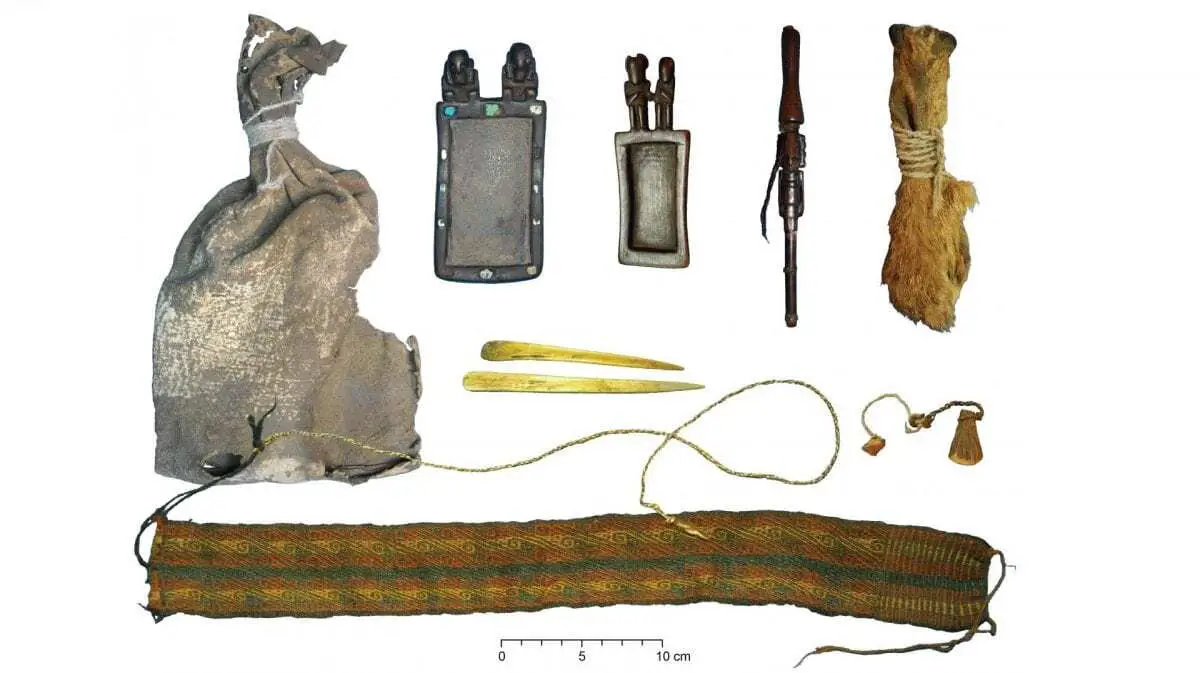Today’s hipster creatives and entrepreneurs are hardly the first generation to partake of ayahuasca, according to archaeologists who have discovered traces of the powerfully hallucinogenic potion in a 1,000-year-old leather bundle buried in a cave in the Bolivian Andes.
Led by University of California, Berkeley, archaeologist Melanie Miller, a chemical analysis of a pouch made from three fox snouts sewn together tested positive for at least five plant-based psychoactive substances. They included dimethyltryptamine (DMT) and harmine, key active compounds in ayahuasca, a mind-blowing brew commonly associated with the Amazon jungle.
“This is the first evidence of ancient South Americans potentially combining different medicinal plants to produce a powerful substance like ayahuasca,” said Miller, a researcher with UC Berkeley’s Archaeological Research Facility who uses chemistry and various technologies to study how ancient humans lived.
She is lead author of the study, published today (Monday, May 6) in the journal Proceedings of the National Academy of Sciences.
Miller’s analysis of a scraping from the fox-snout pouch and a plant sample found in the ritual bundle — via liquid chromatography tandem mass spectrometry — turned up trace amounts of bufotenine, DMT, harmine, cocaine and benzoylecgonine. Various combinations of these substances produce powerful, mind-altering hallucinations.
The discovery adds to a growing body of evidence of ritualistic psychotropic plant use going back millennia, said Miller, a postdoctoral fellow at the University of Otago in New Zealand who conducted the research during her doctoral studies at UC Berkeley.
“Our findings support the idea that people have been using these powerful plants for at least 1,000 years, combining them to go on a psychedelic journey, and that ayahuasca use may have roots in antiquity,” said Miller.
The remarkably well-preserved ritual bundle was found by archaeologists at 13,000-foot elevations in the Lipez Altiplano region of southwestern Bolivia, where llamas and alpacas roam. The leather kit dates back to the pre-Inca Tiwanaku civilization, which dominated the southern Andean highlands from about 550 to 950 A.D.
In addition to the fox-snout pouch, the leather bundle contained intricately carved wooden “snuffing tablets” and a “snuffing tube” with human hair braids attached, for snorting intoxicants; llama bone spatulas; a colorful woven textile strip and dried plant material. All the objects were in good shape, due to the arid conditions of the Andean highlands.
Though the cave where the artifacts were found appeared to be a burial site, an excavation did not turn up human remains. Moreover, the plants found in the bundle do not grow at those altitudes, suggesting the bundle’s owner may have been a traveling shaman or another expert in the rituals of psychotropic plant use, or someone who was part of an extensive medicinal plant trading network.
“A lot of these plants, if consumed in the wrong dosage, could be very poisonous,” Miller said. “So, whoever owned this bundle would need to have had great knowledge and skills about how to use these plants, and how and where to procure them.”
Of particular fascination to Miller is the pouch made of three fox snouts. She describes it as “the most amazing artifact I’ve had the privilege to work with.”
“There are civilizations who believe that, by consuming certain psychotropic plants, you can embody a specific animal to help you reach supernatural realms, and perhaps a fox may be among those animals,” Miller said.
Ayahuasca is made from brewing the vines of Banisteriopsis Caapi and the leaves of the chacruna (Psychotria viridis) shrub. The leaves release DMT, and the vines release harmine — and therein lies the secret of the ayahuasca effect.
“The tryptamine DMT produces strong, vivid hallucinations that can last from minutes to an hour, but combined with harmine, you can have prolonged out-of-body altered states of consciousness with altered perceptions of time and of the self,” Miller said.
Once the drugs take effect, ayahuasca users typically enter a purgative state, which means they vomit a lot.
Though its use is currently fashionable among Silicon Valley techies, Hollywood celebrities and spiritual awakening-seekers worldwide, Miller says these latest archaeological findings pay homage to ayahuasca’s ancient history.
Miller joined the Cueva del Chileno excavation project when archaeologists Juan Albarracín-Jordán of the Universidad Mayor de San Andrés in Bolivia and José Capriles of Pennsylvania State University sought her expertise to identify the plant matter they had found in the bundle.
She traveled for two days to reach the cave site near the remote south Bolivian village of Lipez and helped with the final phases of the excavation. The bundle was transported to a laboratory in La Paz and, once permits were in place, samples were exported to the lab of Christine Moore, chief toxicologist with the Immunalysis Corp. in Pomona, California.
Moore’s lab provided the liquid chromatography tandem mass spectrometry technology needed to conduct toxicology tests on the samples. Once the contents of the Andean bundle tested positive for five kinds of psychotropic substances, Miller’s research team was over the moon.
“We were amazed to see the incredible preservation of these compounds in this ritual bundle,” said Miller. “I feel very lucky to have been a part of this research.”
UNIVERSITY OF CALIFORNIA – BERKELEY
Header Image -Ritual bundle with leather bag, carved wooden snuff tablets and snuff tube with human hair braids, pouch made of three fox snouts, camelid bone spatulas, colorful textile headband and wool and fiber strings. Photos courtesy of Juan Albarracín-Jordán and José Capriles.





